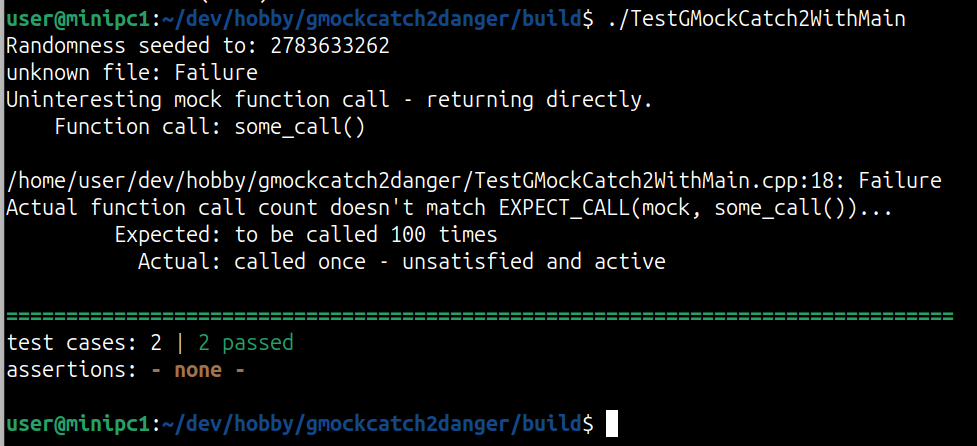The danger of combining GMock with Catch2
Recently I stumbled upon a problem while writing unit tests. The unit tests I wrote were not failing even though they were supposed to fail. At first, I thought I had made a mistake in my mock classes, but the issue turned out to be completely different.
Catch2 is a great BDD (Behavior Driving Development) framework for C++, however it lacks a main functionality; Mocking. Therefore it would be useful to deploy GMock at this point. However this comes with a great danger. In this post I want to write about the danger and possible pitfall of combining GMock with Catch2 or possibly any other unit testing framework.
One might think: why not GoogleTest? The question is understandable but GTest does not offer BDD. It is designed to write TDD tests. Therefore it is a combination, which makes completely sense.
I will share the complete code in my repository.
Writing a very basic mock
Let’s start with a very basic class and the mock for this class:
1 | class ClassToTest{ |
This should be pretty straightforward. We have a class we want to test, ClassToTest, and the corresponding mock class, MockClass. Now, let’s add a caller for that class:
1 | class SimpleWrapper{ |
The SimpleWrapper takes an ClassToTest as reference and allows us to call its some_call method. Now we are ready to test our class.
Writing and running some tests in Catch2
In this phase we can write some tests to check our class with Catch2. Here are some very minimal tests:
1 | using namespace ::testing; |
In the first test case we define a StrictMock and don’t set any expectations. However we call our function through our SimpleWrapper. The strict mock should report us the unexpected e.g. uninteresting call as an error. Therefore this is obviously a failed test case.
In the second test case, we define a NiceMock, which doesn`t affect our test case in terms of unexpected calls. The goal here is to set an expectation on some_call. We expect that our function gets called 100 times within this scope. However, we call it only once. This is, again, an obvious failed test case.
Running the test
Lets run our tests, which should obviously fail:

This result is interesting and not what we would expect or want. Let’s simply run and see the output of our executable:

The result is still the same however we can see that something is odd. Here’s what happens: we are using the precompiled main() of Catch2, which simply looks something like:
1 | // Simplified from catch2/src/catch2/internal/catch_main.cpp |
That means we are getting the result of our tests from Catch2::Session. However the question is: does Catch2 recognize that GMock/GTest expressions are failing? The answer is NO!. The tests that are being conducted by Googletest must be passed to the Catch2. And Googletest developers have addressed this issue:
Using Google Mock with Any Testing Framework
TLDR: If you want to use GMock with other testing frameworks, it must be fine-tuned.
This issue is pretty obvious and straightforward after reading about it or figuring it out. However, it’s a really painful problem that will most likely cause someone to spend days trying to understand what’s happening without knowing the root cause.
Summary
Catch2 and GMock together form a very strong testing combination. However they do not work together out of the box. This might trick you into pushing a buggy code into the production.
Thank you for reading. The source code for this post can be found here In the next post, I will go into detail on how to solve this issue.
The danger of combining GMock with Catch2